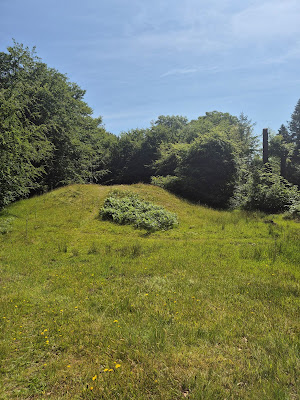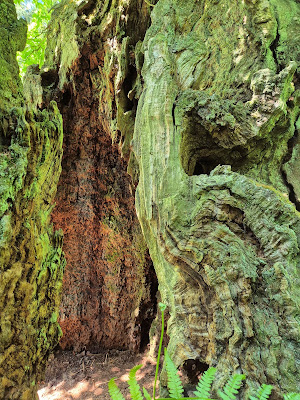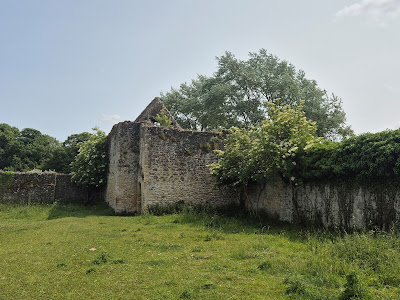Once again, it was the time of year when the Severn tunnel is closed for maintenance - very important - and whoever it is who runs the railways these days fails to put on an even half-decent replacement coach service between Cardiff and Bristol. Not wanting the Northerner to have to return home via Gloucester and, per chance, Swindon, I drove him to and from work on the days it was possible for me to do it - four in all.
Although eight hours is a long day out, I wanted to stay in Wales if I could, to reduce costs and my carbon footprint, but one day was forecast to be full of heavy rain and thunderstorms, and another over 30°C, so on those days I made the two round trips, regretting my decision the second day when it took me two and a half hours to cover the 36 miles from home to his workplace on Newport Road in extreme heat.
The other two days were hot but not oppressively so, so Cwtch and I pored over walk books and websites and found two places in nearby Gwent for us to visit.
First stop, the Sirhowy valley, in the next valley from where Son the Younger used to live, so full of familiar skylines. The outward leg of our circular walk started just south-west of Crosskeys and took us along a disused railtrack, the former signal box now seeing service as a toilet.


high above the River Sirhowy
sycamore and whitethorn
foxglove
It's an easy walk through the woods, though given the number of little streams crossing the path, I imagine it must be muddy in places when it's not summer.
There were some quite steep steps to climb at the point where our route turned back on itself, which caused my knees to grumble a bit, but we made it.
Cwmfelinfach
Returning along a higher path, there were some lovely views along the valley to where the Sirhowy meets the River Ebbw. I was thrilled to hear both a cuckoo and a curlew.
non-native fiddleneck
enough hemlock water dropwort to poison the entire population of the British Isles
one of many self-seeded alders lining the path
broad-leaved marsh orchid
marsh valerian
The worst bit of the walk was right at the end when our route took us down an extremely steep, stony path to our starting point, but again I managed to negotiate it without doing myself any damage. I think I might try the longer walk through Sirhowy Country Park next time, as it's definitely worth a revisit.
Our second destination in Gwent was Wentwood , formerly ancient woodland that was part of Chepstow Castle's hunting grounds and is now mostly conifer plantation (though the long and laborious job of replanting native species has started). I was following a walk I'd found online that would take me to the Curley Oak, reputed to be between five hundred and a thousand years old.
distant view of England adrift across the Severn
Our route took us past not one but two Bronze Age round barrows in a truly lovely spot.
Fallow deer slots
The track through the woods was still quite muddy in places, despite the warm and (mainly) dry summer weather we've been having.
heath-spotted orchid
honeysuckle
yellow pimpernel
Our route to the oak relied heavily on waymark posts, rather than giving estimated distances between instructions, which was a shame as many of them were no longer in place. Much of the time I had to guess whether a path was the right one, and we did get a bit lost, but not in that trackless-middle-of-the-wildwood way; it was more 'well, I'm pretty sure the car park is back in that direction so I'll take this path for now and head left when I get a chance'. I made a few of my own waymarks for the return leg.
Eventually - having been distracted by its fence and missed it altogether - we looped back around and reached the Curley Oak. I have to say, it looks rather older than five hundred years to me.
As is the custom with ancient trees, people had left little gifts for it, the most striking of which were limpet shells. I'd picked up a bit of blue pottery earlier on our route, so I left that.
I felt a bit of a pang standing there, as Curly was my father's old nickname and the name his grandchildren called him. I'd have liked to have learnt about this tree thirty years ago, when he was still strong and I could have walked to see it with him. But in any event, it was a stunning high point for a walk.
Since I was in the area with time to spare, I did stop off in Cardiff to visit another memorable tree, this one a London Plane near Roath Park that's in the process of eating a Victorian pillar box.
And I also got to while away a couple of hours in a favourite spot in Llandaff, namely the wild bit of the graveyard in the Cathedral precinct. Even under the trees it was hot, though, so Cwtch and I headed down to the River Taff where there was a bit of a breeze.
Cwtch is still too scared of water to chase the ducks, thankfully.
It must have been during the 1980s that I last stood in this spot. Much water over the weir since then.











.jpg)














































































